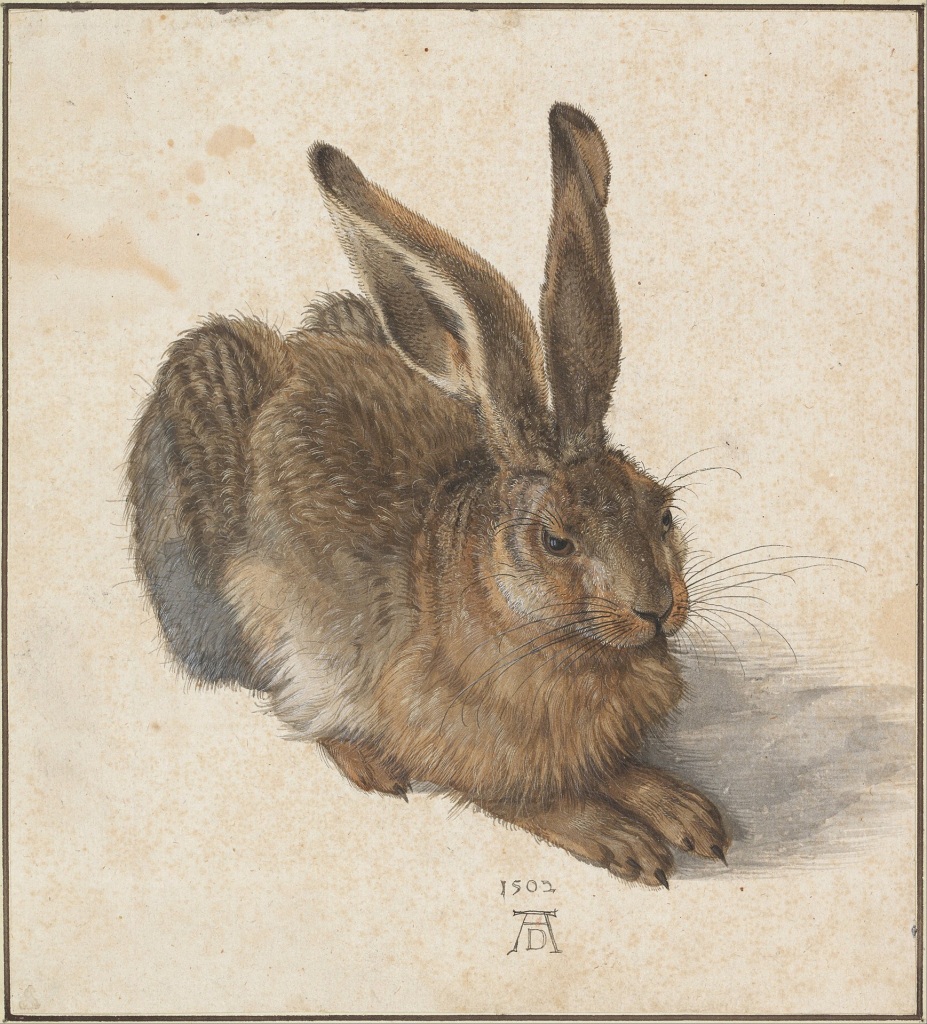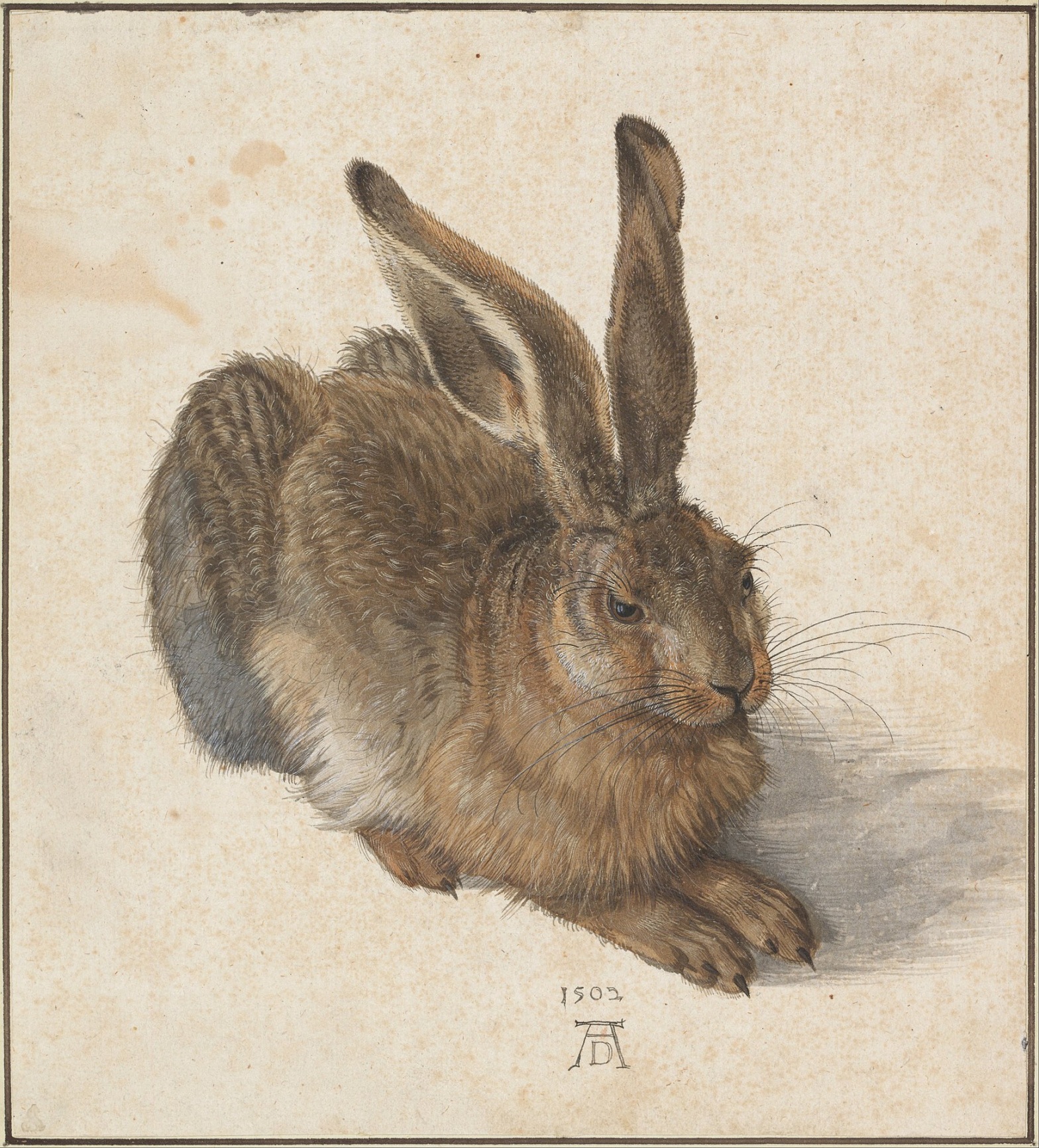Albrecht Dürer’s “Young Hare,” created in 1502, is a remarkable watercolour painting celebrated for its exceptional observational artistry. Despite its title, the meticulous level of detail in the artwork enables the hare to be recognized as a mature field hare. Dürer adeptly captured the intricate fur patterns and shading of the hare, utilizing innovative techniques to depict the interplay of light on the subject.
Albrecht Dürer’s “Young Hare”

The painting not only demonstrates the artist’s technical prowess in portraying a multi-textured subject with varied fur directions, but also emanates a warm golden light that infuses the portrait with a lifelike quality. The play of light and shadow in the artwork accentuates the hare’s features, imparting a compelling sense of vitality and realism.
Dürer’s Monogram
In addition to his remarkable artistic talent, Albrecht Dürer was known for incorporating his monogram into the majority of his works. Located at the bottom center of his artworks, Dürer’s monogram served as his signature, proudly representing his initials “AD” for Albrecht Dürer. This practice was common among artists during the Renaissance period, serving as a means to authenticate their works and assert their authorship. The inclusion of the monogram not only personalized each piece, but also ensured the recognition of Dürer as the master behind these exceptional creations
Who was Albrecht Dürer
Albrecht Dürer, renowned German painter, printmaker, and theorist, was born on May 21, 1471, in Nuremberg, Holy Roman Empire. Dürer’s profound influence on the art world stemmed from his exceptional skill in various mediums, including woodcuts and engravings, which earned him widespread acclaim during the Northern Renaissance.
His extensive travels to Italy greatly impacted his artistic style, leading to the fusion of German and Italian artistic principles in his works. Dürer’s passion for innovation and meticulous attention to detail are exemplified in iconic pieces such as “Young Hare”.
As a pioneer in the realm of art theory and practice, Dürer’s treatises on measurement, perspective, and proportion left a lasting legacy, solidifying his status as a key figure in art history. His dedication to elevating the status of the artist as a creative intellect and his unyielding pursuit of artistic excellence continue to inspire countless creators to this day.
Albrecht Dürer passed away on April 6, 1528,, leaving behind a rich artistic legacy that resonates through the annals of time. He is the best-known and arguably the greatest German artist of the Renaissance, whose work was admired and influential throughout Europe.
As I grew older, I realized that it was much better to insist on the genuine forms of nature, for simplicity is the greatest adornment of art.
Albrecht Dürer


Just by chance have I come across this wonderful and interesting article about Alfred Dürer and his many talents! Many thanks🌻
LikeLiked by 1 person
Dear Rebecca
It’s a pity that this picture of hare is so much used and reproduced that it has lost its power. In the generation of my parents you find a reproduction of it in nearly every home, you find it at furniture shops and second rate interior design shops, in old hotels etc. – actually, one can’t escape it. Art that is used that much looses its magic. By the way, there is another Dürer picture of the hands of his mother that shared the same fate. Fame trivialises these like all pictures.
All the best
The Fab Four of Cley
🙂 🙂 🙂 🙂
LikeLiked by 2 people
Dear Klausbernd,
Thank you for your insightful comments, which reminds me that many famous and well-known art appears on t-shirts, caps, and posters: Mona Lisa, Eiffel Tower, The Scream, Starry Night, The Birth of Venus. I agree wholeheartedly – “art that is used that much loses its magic.” Fame can diminish the value of paintings that are excessively reproduced and seen as common.
But I confess that I had never heard about Albrecht Dürer “Young Hare” before I came to your post March 31, 2024 post that featured Dina’s remarkable captures of hares. I had to find out more. http://fabfourblog.com/2024/03/31/meet-the-hares/
ChasingART is my exploration into the stories behind paintings and artists that I have never encountered. Right now, I am looking into the life of Edmonia Lewis who was an American sculptor of African American and Native American heritage, born in 1844. She gained recognition for her neoclassical sculptures during the 19th century. Lewis was the first woman of African American and Native American descent to achieve international fame as a sculptor. Her works often focused on themes of abolitionism and the Civil War, with pieces like “Forever Free” and “The Death of Cleopatra” showcasing her talent and dedication to her craft. Lewis overcame significant barriers as a woman of color in the art world of her time and left a lasting legacy as a pioneering artist.
I continue to learn and learn! Thank you for adding so much to my knowledge., Klausbernd. Sending much love and many hugs to my dear friends, The Fab Four of Cley!
LikeLike
It’s a pity, dear Rebecca, for some unknown reasons I can’t like your answer.
Wishing you all the best
Klausbernd 🙂
LikeLiked by 1 person
There are some WordPress Mysteries that will remain unsolved. LOL!!! Sending many good wishes back your way.
LikeLike
Sorry, of course, the text has to be
I can’t find the answer – well these correction programmes …
LikeLiked by 1 person
That painting is amazing. I was looking at the detail on the ears and the light hairs on the coat. Thanks for the introduction to this piece and to Durer, Rebecca. It’s stunning.
LikeLiked by 1 person
I am so glad that you enjoyed this post, Diana. I have read that Dürer acknowledged his artistic talent, evident in his many self-portraits and depictions in his commissioned pieces. Regarded as an early figure in the art world, he drew imitators, disciples, and fans, establishing a model for upcoming artist-celebrities. But it seems that he saw his talent as a curse as well as a blessing. He was quoted as saying: “Why has God given me such magnificent talent? It is a curse as well as a great blessing.”
LikeLiked by 1 person
Ah, I think talented authors who bemoan their magnificent talent are probably being a little self indulgent. Lol
LikeLiked by 1 person
The detail in this painting is delightful. It is what I aspire too in my own painting. I will look and this artist’s other works.
LikeLiked by 1 person
I am looking forward to our discussion on your artistic journey, Robbie. I am so pleased you enjoyed this post.
LikeLike
This is a truly gorgeous painting of a hare. I’m actually aghast.
I love animals, and this hare is now dear to my heart. 1502… daily I marvel more and more at, about, and of art.
Art is the truest and richest of humans’ legacy.
Thank you for this article, Rebecca!
LikeLiked by 1 person
I am delighted that you enjoyed this post, Resa! What I found most interesting about Albrecht Durer was that he drew inspiration from his travels throughout Europe, where he studied art and architecture. He also found inspiration in nature, particularly in his detailed studies of animals and plants. Dürer was influenced by the works of Italian Renaissance artists, which he encountered during his visits to Italy.
Even the most brilliant artist, is inspired by others, by nature and by travel.
LikeLiked by 1 person
Agree, 100%
LikeLiked by 1 person
Nature is very inspiring.
LikeLiked by 1 person
I agree, Robbie. I think in many ways we have arrived home when we seek the company of nature.
LikeLiked by 1 person
Yes, it is not something we necessarily seek out as youngsters. Bright lights and the fast lane soon lose their allure when you’ve had them for a while. At least for me they did.
LikeLiked by 1 person
For me, as well, Robbie!
LikeLike
Yes! I know.
LikeLiked by 1 person
Eine grossartiges Aquarell von Dürer. Ich mag es sehr. Ich sende Dir Grüsse nach Übersee. Ernst
LikeLiked by 1 person
Vielen Dank für Ihren Besuch, Ernst. Albrecht Dürer war ein bemerkenswerter Künstler. Wie wunderbar, dass wir seine Gemälde sehen und genießen können.
LikeLiked by 1 person
Yes! And there is a rabbit statue honoring him, and his painting in his home town of Nuremberg, near his home. Looks very similar.
LikeLiked by 1 person
Many thanks for adding to my knowledge, Cindy. Very much appreciated. How wonderful to have traveled to his home town of Nuremberg. I remember passing by on a train, but regrettably did not stop!
LikeLike
The level of detail in “Young Hare” is absolutely astonishing! Great topic for a post, Rebecca!
LikeLiked by 1 person
I am so pleased that you enjoyed this post, Dave. I am fascinated by Albrecht Durer’s paintings ever since I came upon his “Self-portrait” at 28 which he completed in 1500. It has religious overtones.
#/media/File%3AD%C3%BCrer_Alte_Pinakothek.jpg)
I read that Albrecht Dürer did not paint himself as Jesus but he portrayed himself with Christ-like features, such as long hair and a beard, leading to speculation and debate among art historians about his intentions.
Digging a little further, I read that the medieval view of the stages of life marked the transition from youth to maturity at 28. So this self- portrait commemorates a turning point in the artist’s life and in the year 1500.
I continue to learn and learn and learn!!!
LikeLiked by 1 person
It’s hard to believe that level of detail could be accomplished with watercolors!
LikeLiked by 1 person
I did not know the extent of Durer’s talent, Liz. I just found out that he was also a skilled mathematician and wrote several theoretical treatises on perspective and proportions. I found these quotes which I found very interesting and indicative of his complex mind.
“Why has God given me such magnificent talent? It is a curse as well as a great blessing.” Albrecht Dürer
“But I shall let the little I have learnt go forth into the day in order that someone better than I may guess the truth, and in his work may prove and rebuke my error. At this I shall rejoice that I was yet a means whereby this truth has come to light.” Albrecht Dürer
LikeLike
I love that second quote: talented and humble!
LikeLiked by 1 person
And so in tune with how we all participate in the evolution of knowledge!!!
LikeLiked by 1 person
Yes!
LikeLiked by 1 person
This rabbit is stunning! It looks like a photo. I like the details and the coloring. It makes the rabbit look so real!
LikeLiked by 1 person
Wasn’t Albrecht Dürer’s truly amazing. I read that he was able to create lifelike photographic images through his exceptional skill in using perspective and proportion in his artworks. His meticulous attention to detail and innovative techniques in printmaking, such as woodcuts and engravings, allowed him to achieve a level of realism that was unprecedented during his time.
I am delighted that you stopped by, Colleen. Thank you!
LikeLiked by 1 person
What a gift to see the detail like this artist did. I love this. Robbie Cheadle would love this painting.
LikeLiked by 1 person
Durer’s art never ceases to amaze me!
LikeLiked by 1 person
I am delighted that you stopped by Judith. I share your amazement. Dürer’s understanding of light and shadow, combined with his ability to capture intricate textures and facial expressions, contributed to the lifelike quality of his works that resembled photographs despite predating the invention of photography by centuries.
LikeLiked by 1 person
Imagine the patience required to produce a work like his “Young Hare”. Absolutely mind-boggling!
LikeLiked by 1 person
I agree wholeheartedly, Judith!
LikeLiked by 1 person